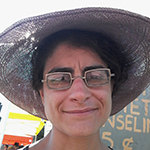The Kindly Ones
Dear Ms. Phillips,
We at – are interested in taking care of
your real estate needs [we can take this
from you] and it has come to our attention
that, as administrator of the estate of –
you may now be in ownership [you, kin
of your father, in whose image – ?
you inherit – ?] of the property at – [will you still call this home?].
We would be happy to work with you.
Whether you are interested in renting
[what does he owe?] or selling [now we come to receive you,
we, your cousins, your home]
the property, we guarantee [as we are we,
as we are here with/in you] we will protect [vow tucked under his tongue—what now
will he say for himself – ?] of your fiscal
interests—no matter the state
of the property [flooding, rotting, falling,
the house of Atreus, of Cadmus, again]
we have a team of talented professionals
to aid you in this time [how long
has it been since you’ve lost,
since the house, since the man,
do you remember – now, what now?
since then? now, after – ].
We will assign a qualified real
estate agent [should he wander, should he rest,
we will find him, again, even now, after – ]
to handle the property [ – after fury,
what do you do with the remains, after – ]
in any way you see fit [we have seen him,
we have seen the body – let us feast]
and serve as a consultant [sister-cousin,
ask us how we know]. From sales
to mortgage financing [what’s fitting to note],
property management [as you create him,
with fury, so you we – ] to homeowner’s
insurance [villainous he, furious we],
we are here every step [sister, we have been here,
have seen him, have spoken the name
of the dead, have gathered, perched
on the rooftop of this house, nails tap tapped
on windowpanes – let us in let us in – the man
on the couch breathing, not breathing, he was here]
of your real estate journey.
We have thousands of agents [we are]
in several offices [here] across the U.S.
[we are here], all ready [we are here]
to serve [with/in] you [we can take this]
and your property [we can take this from you].
[Sister, we have come to you for the feast,
for the shelter, your guests, we are, kindly
sister, furious sister, we will call you home].
Thanks again, and we hope you choose – for your real estate needs.
Theme in Red
Instead of an apartment,
we decide to live in a pomegranate.
We search for the proper size and ripeness,
the right richness of color,
the perfect shade of velvet, an essential
red. We are the masters of real estate,
discovering such a steal buried in a pile
of wrong picks at the farmer’s market, just $3
for a mouthful of home.
Moving is difficult, as it always is
in this city. But we fit inside the palm
of the mover’s hand, and we split the rind
into a doorway wide enough for years
of heres and theres, the unabridged
history of the soles of our feet.
Each seedless pocket of fruit is a room,
and they are infinite, a room for recalling
the things we’ve forgotten, a room
for the unpracticed waltz and improvised tango,
and a room for considering impossible things,
where we live most of the time, dreaming
of mansions cut of dragon fruit
and summer homes furnished
from blood orange and red pear.
Every morning we eat
ourselves out of our rooms.
We fill all our pockets with seeds.
We are never hungry for anything.
The juice seeps into all of our clothing,
the linens, the furniture, this stubborn red
we picked, so we are stained
with the evidence of our living.
We are a mess at dinner parties.
We apologize for nothing.
We crimson with laughter.
We lick the joy off our lips.
We wake every day singing
from the fevered red rooms of our hearts.
Maya Phillips was born and raised in New York. Maya received her BFA in writing, literature, and publishing from Emerson College and her MFA in poetry at Warren Wilson’s MFA Program for Writers. She currently works as the associate content producer at the Academy of American Poets and as a freelance arts journalist. She lives in Brooklyn.


 BACK TO ISSUE
BACK TO ISSUE